
Happy New Decade! Keep giving thanks to be living in the best time of human history.......every day of the new decade!
Scroll down and enjoy the latest comprehensive weather to the max...... occurring because of the natural physical laws in our atmosphere as life on this greening planet continues to enjoy the best weather/climate in at least 1,000 years(the last time that it was this warm) with the added bonus of extra beneficial CO2.
Very mild Southeast, Very cold West. How far southeast will the cold shift be in week 2? My forecast has been getting colder in week 2 and leans that way again today..........although the natural gas market did not agree completely on Friday.
Merry Christmas present to humanity: https://www.marketforum.com/forum/topic/44802/
Winter Weather Forecasts
Light Snow in the Great Lakes/Northeast. Many feet of snow will start piling up in the N.Rockies/West the next 2 weeks.
https://www.wpc.ncep.noaa.gov/wwd/winter_wx.shtml
Snowfall the next 7 days below.
Here are the latest hazards across the country.
 |
Purple/Pink/blue on land is cold/Winter weather. Brown is wind, Green is flooding. Gray is fog. Reddish is a red flag advisory.
Go to the link below, then hit the location/county on the map for details.
https://www.spc.noaa.gov/ Go to "hazards"
https://www.mesonet.org/index.php/weather/map/us_air_temperature/air_temperature

https://www.mesonet.org/index.php/weather/map/wind_chill_heat_index1/air_temperature

Current Weather Map
| NCEP Days 0-7 Forecast Loop | NCEP Short-Range Model Discussion | NCEP Day 3-7 Discussion |


Current Jet Stream

| Low Temperatures Tomorrow Morning |

Highs today and tomorrow.



Highs for days 3-7:
Another surge of warmth Eastern half. Cold deepens in the West to far N.Plains.
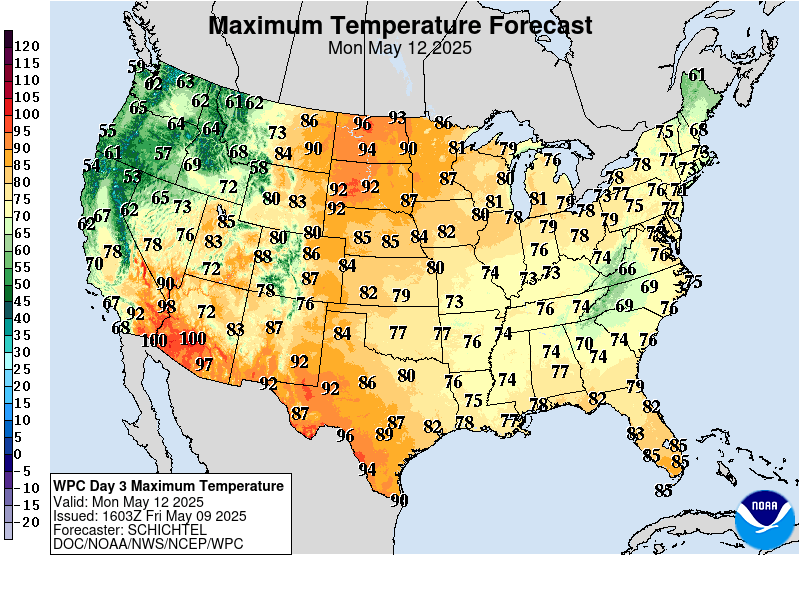
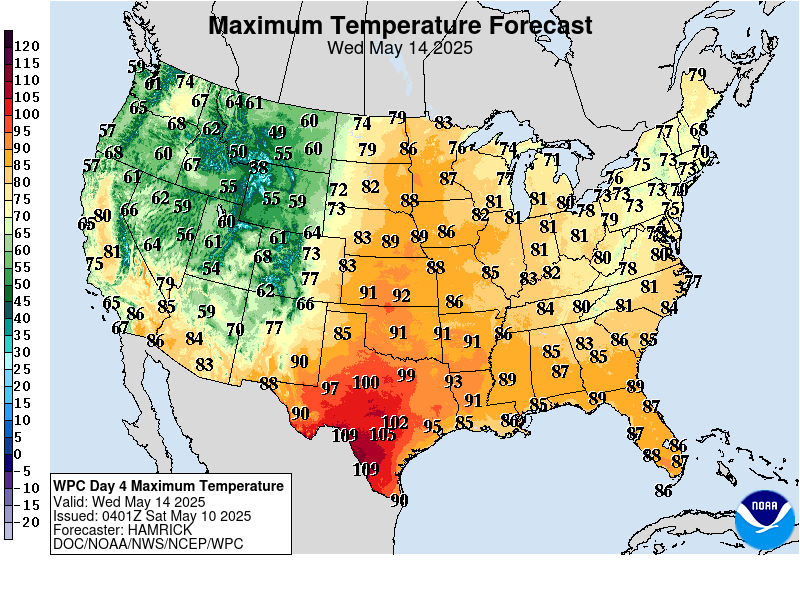
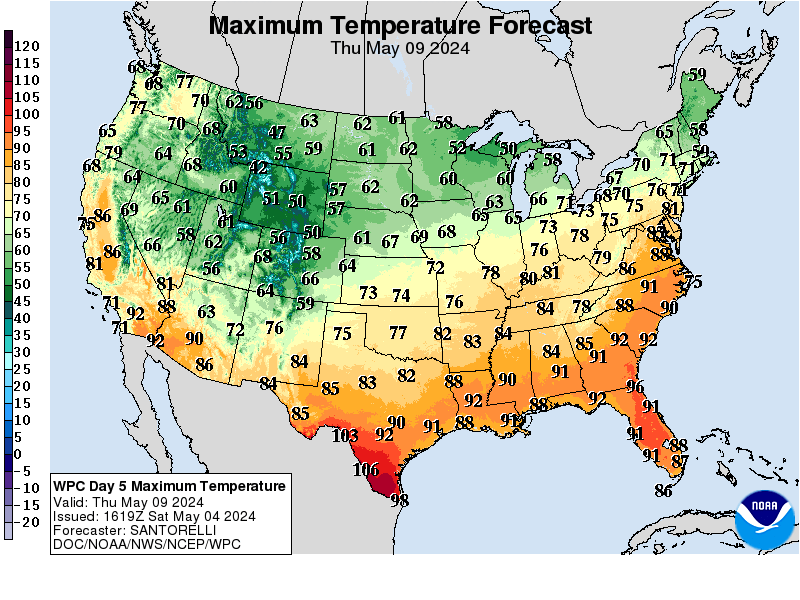
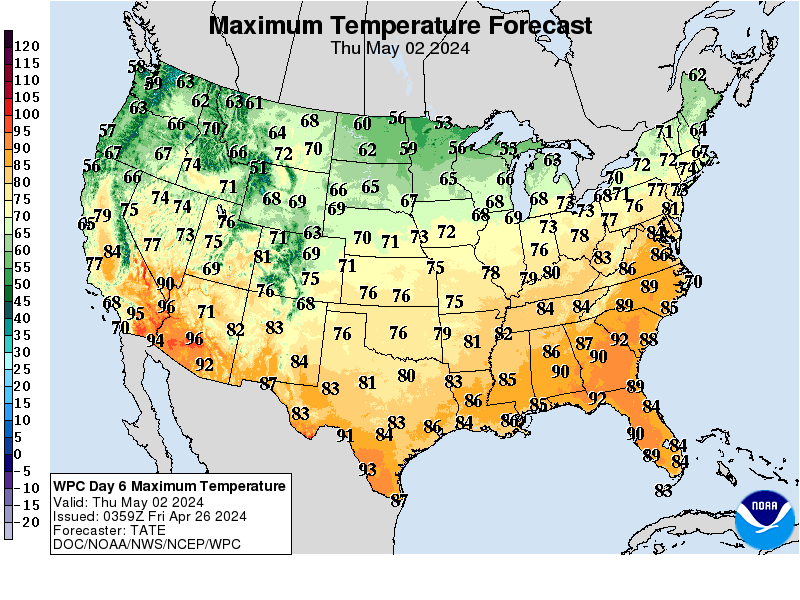
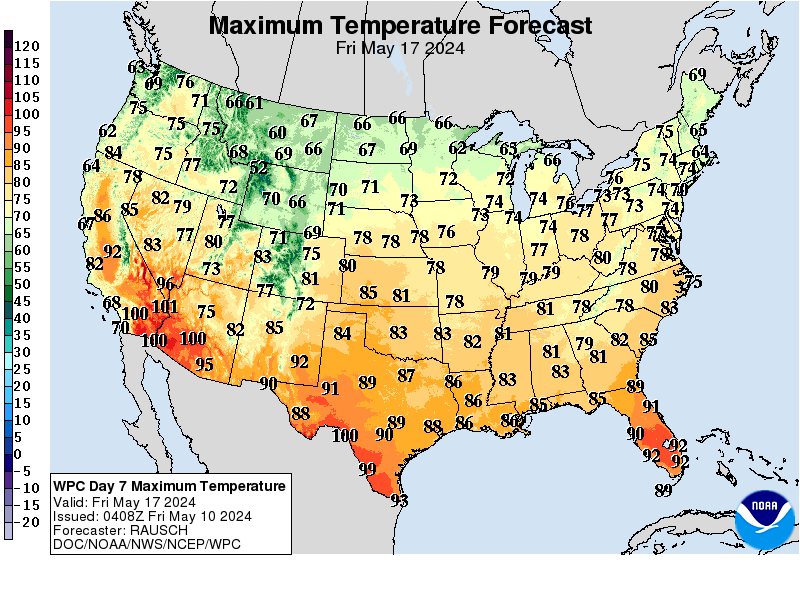
Temperatures vs average for days 3-7.
Another big surge of warmth boosts the magnitude of the positive/red anomalies. Cold/blue anomalies will grow tremendously the next week on this map for the West.
https://www.wpc.ncep.noaa.gov/medr/medr_mean.shtml
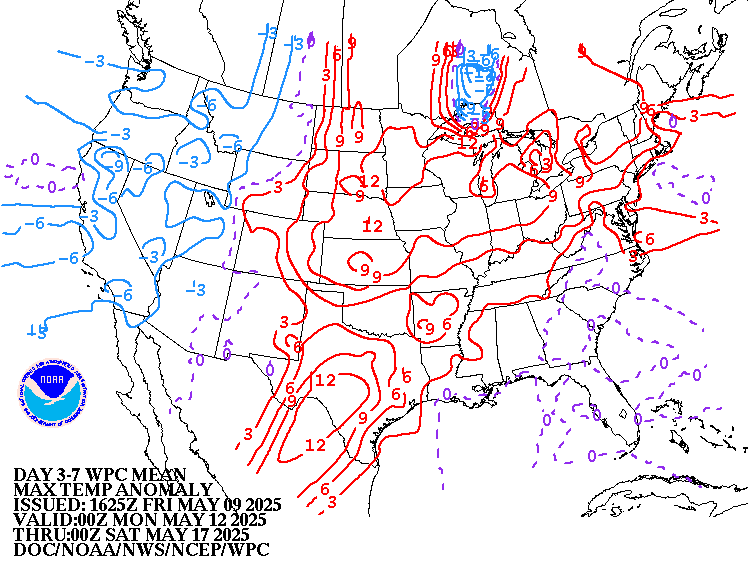
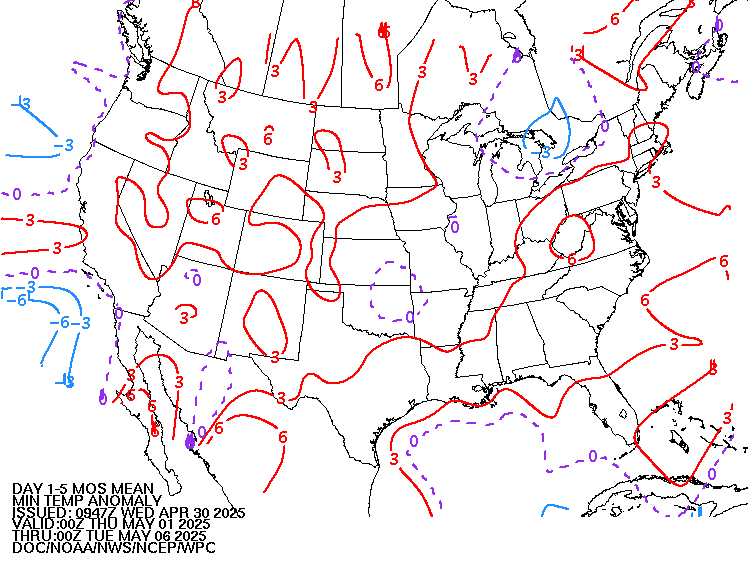
Liquid equivalent precip forecasts for the next 7 days are below.
Huge Action shifts to the Northwest US!
Several inches of rain from a potent southern stream system near the end of the week.
Day 1 below:
http://www.wpc.ncep.noaa.gov/qpf/fill_94qwbg.gif?1526306199054
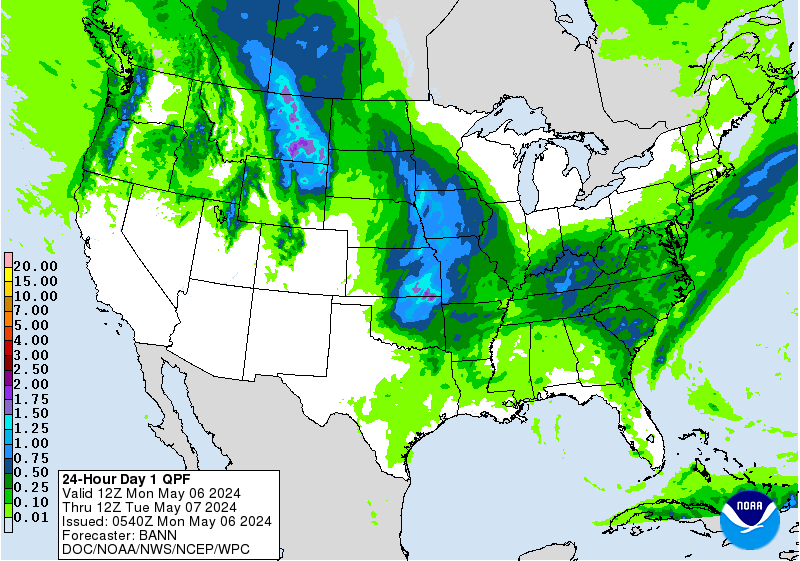
Day 2 below:
http://www.wpc.ncep.noaa.gov/qpf/fill_98qwbg.gif?1528293750112
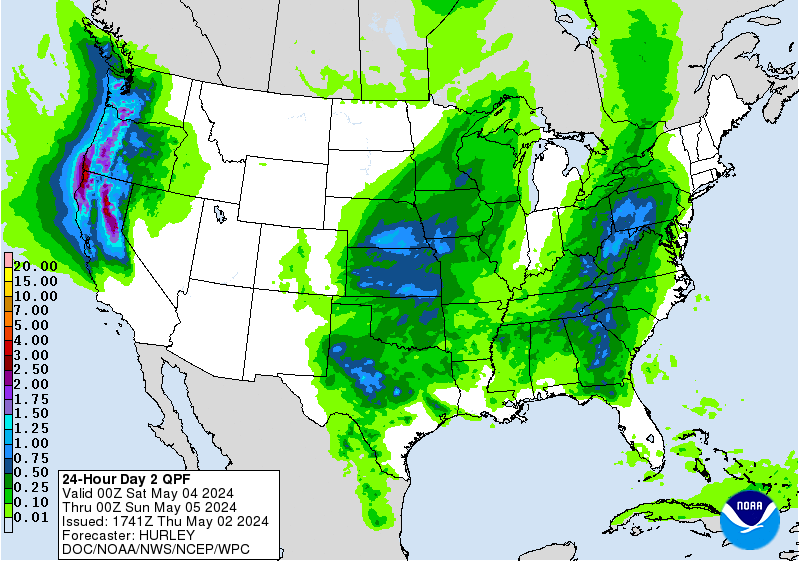
Day 3 below
http://www.wpc.ncep.noaa.gov/qpf/fill_99qwbg.gif?1528293842764
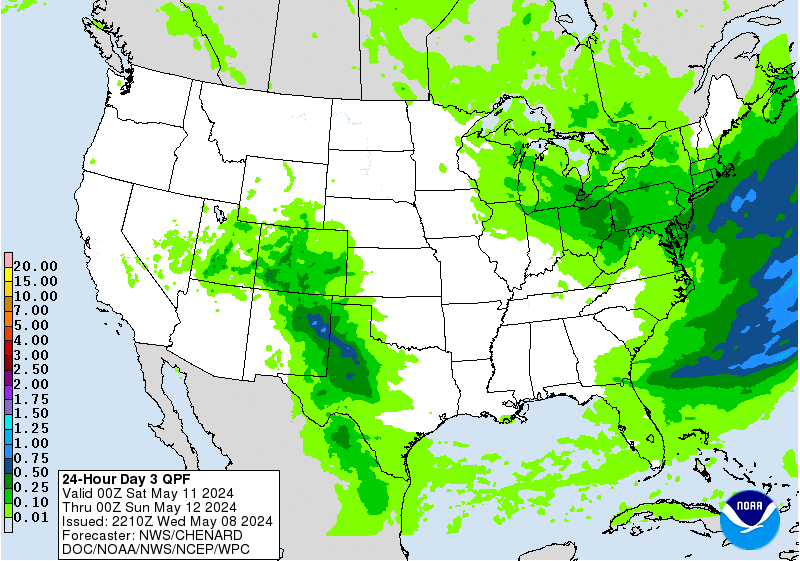
Days 4-5 below:
http://www.wpc.ncep.noaa.gov/qpf/95ep48iwbg_fill.gif?1526306162
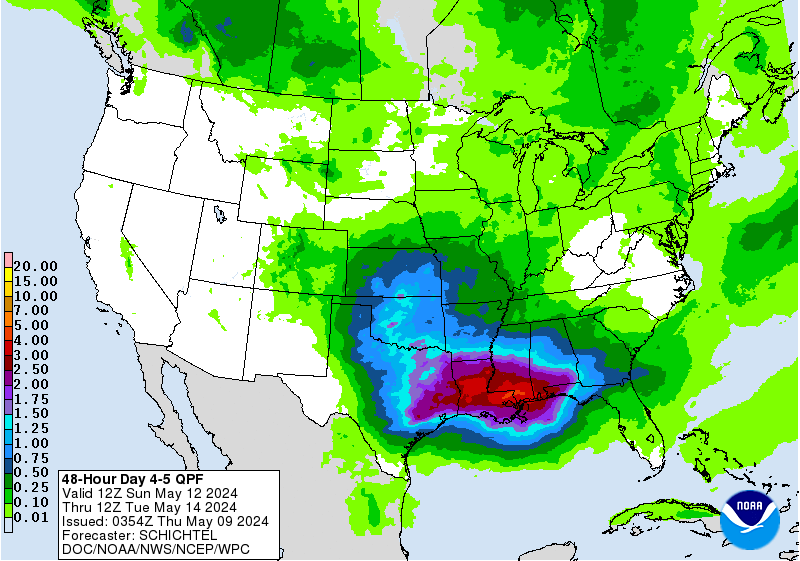
Days 6-7 below:
http://www.wpc.ncep.noaa.gov/qpf/97ep48iwbg_fill.gif?1526306162
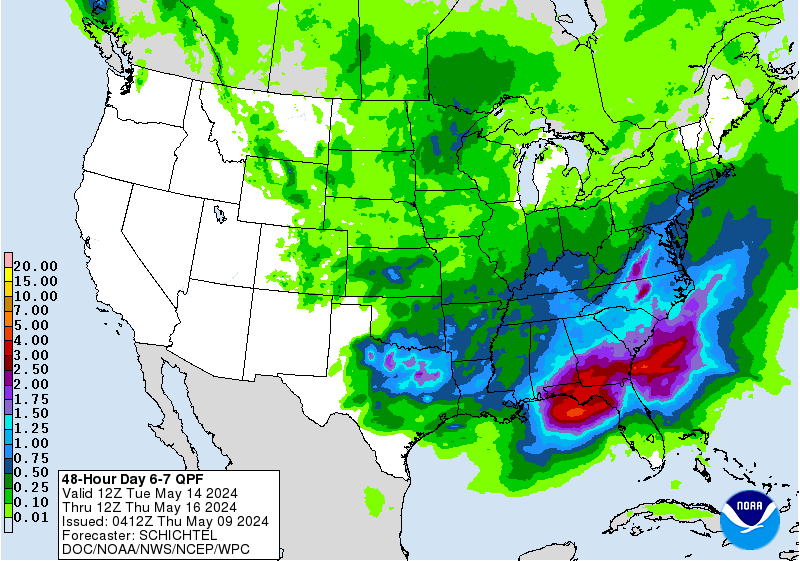
7 Day Total precipitation below:
https://www.wpc.ncep.noaa.gov/qpf/p168i.gif?1566925971
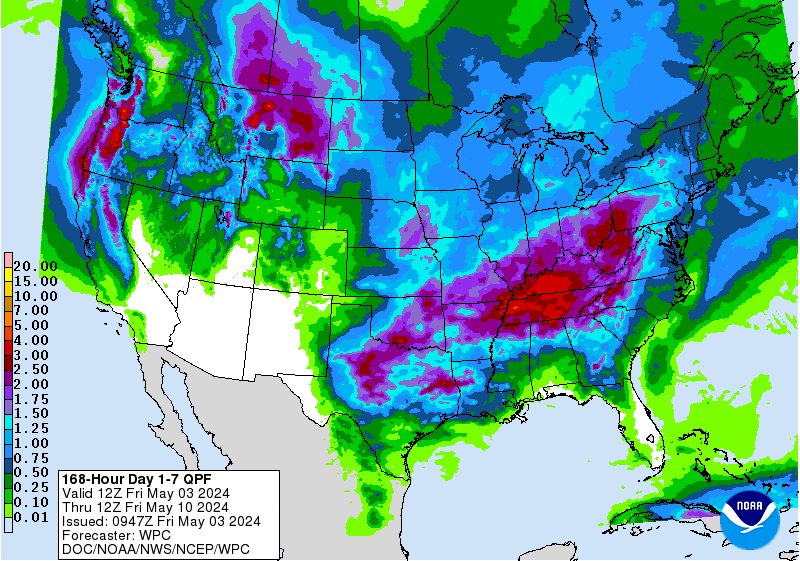
Last 24 hour precip top map
Last 7 day precip below that
Current Dew Points

Latest radar loop
http://www.nws.noaa.gov/radar_tab.php


| (3400x1700 pixels - 2.2mb) Go to: Most Recent Image |

Go to: Most Recent Image
You can go to this link to see precipitation totals from recent time periods:
https://water.weather.gov/precip/
Go to precipitation, then scroll down to pick a time frame. Hit states to get the borders to see locations better. Under products, you can hit "observed" or "Percent of normal"
Soilmoisture anomaly:
These maps sometimes take a day to catch up to incorporate the latest data(the bottom map is only updated once a week).
https://www.cpc.ncep.noaa.gov/products/Soilmst_Monitoring/US/Soilmst/Soilmst.shtml#
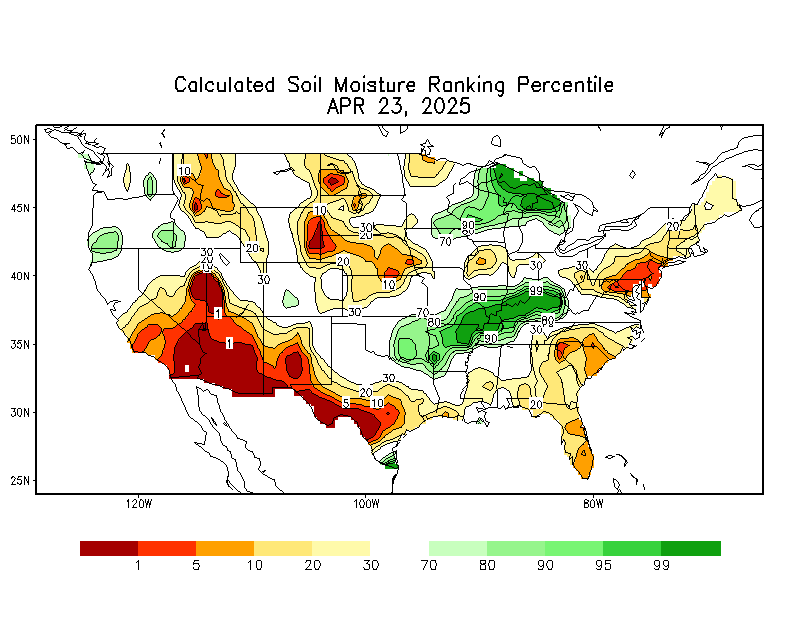
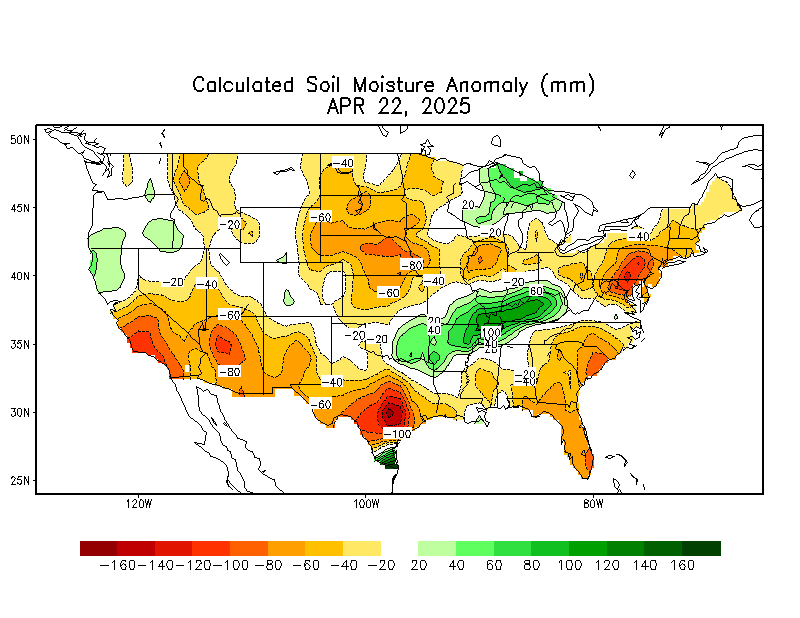
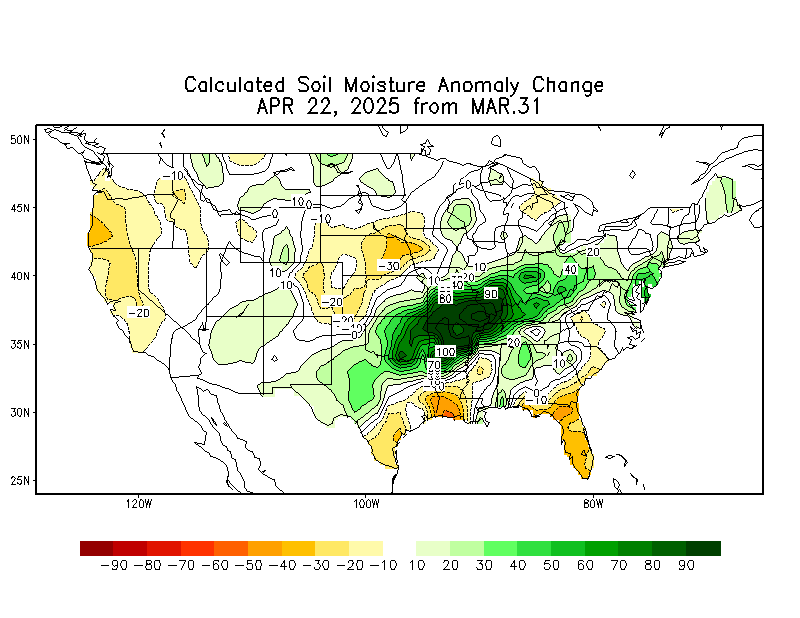
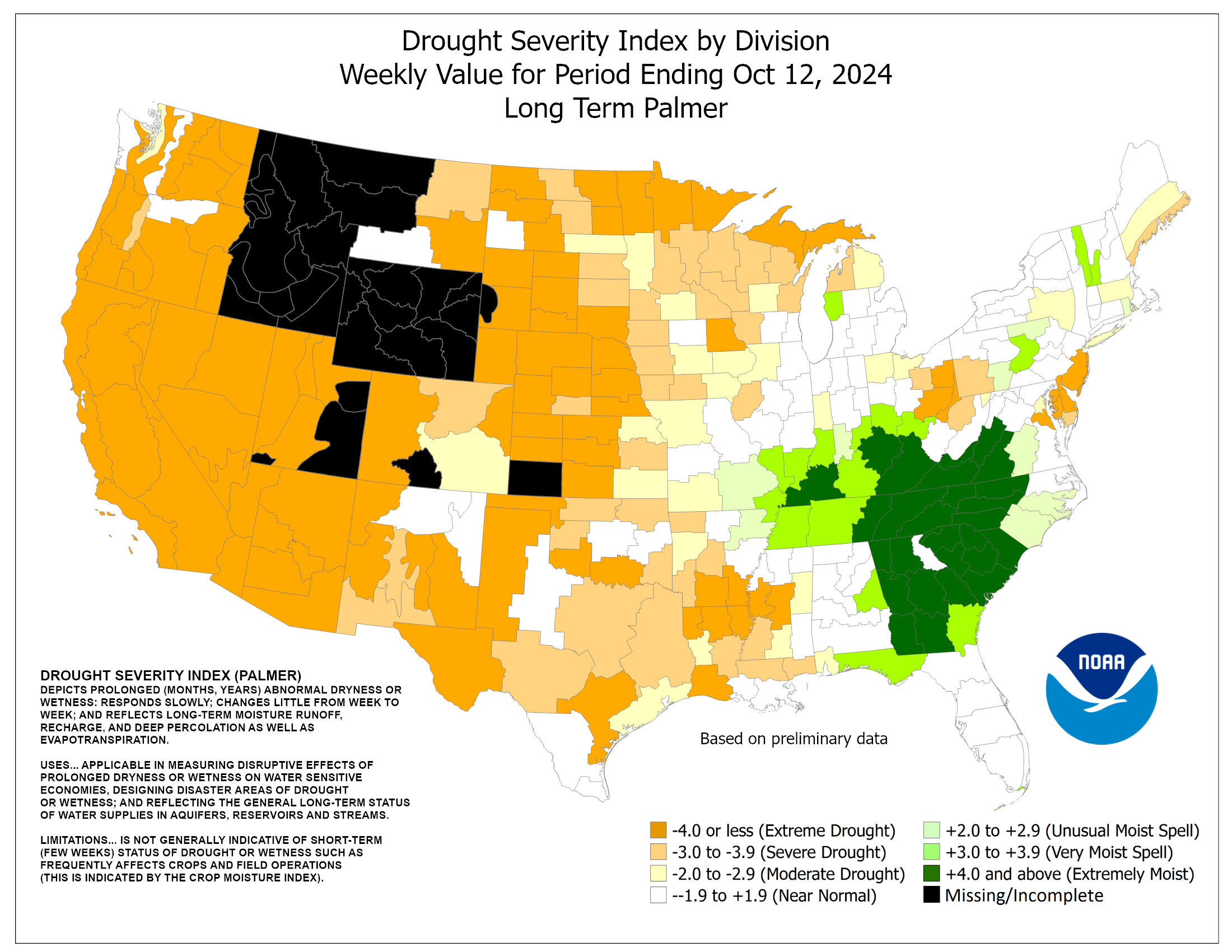

Drought Monitor maps:
Latest: The first map below is the latest. The 2nd one is from last week.
In july/August/Sept/Oct, it's typical to see some increase in drought because of evaporation, seasonally exceeding low rainfall during those months. However, this year saw a HUGE increase in the Southeast!
December 26: DROUGHT the last 2 months has really shrunk. It's GONE in the Southeast! Wow! One area to watch is sw Kansas and S.Plains for the Winter wheat crop but it's going dormant right now.
The maps below are updated on Thursdays.
https://droughtmonitor.unl.edu/


The top map is the Canadian ensemble average, the maps below are the individual members that make up the average at the end of week 2.
+++++++++++++++++++++++++++++++++++++++++
Each member is like the parent, Canadian model operational model.......with a slight tweek/variation in parameters. Since we know the equations to represent the physics of the atmosphere in the models are not perfect, its useful to vary some of the equations that are uncertain(can make a difference) to see if it effects the outcome and how.
The average of all these variations(ensembles) often yields a better tool for forecasting. It's always more consistent. The individual operational model, like each individual ensemble member can vary greatly from run to run.........and represent an extreme end of the spectrum at times. The ensemble average of all the members, because it averages the extremes.............from opposite ends of the spectrum.........changes much less from run to run.
End of week 2....................0z Canadian ensembles:
Updated 12z maps available this late...........turning colder late week 2 vs previous solutions. Potential for another polar vortex incursion south...on some solutions, mainly this particular model!
Starting with last week below:
Last Wednesday: Still cross polar flow into Alaska(which will be frigid) and Canada. How much of that will make it south with the fairly zonal, mild flow in the US(but with weak troughing)? It will be very difficult to keep a massive very cold air mass in Canada from tracking south of the US border, despite what the models think right now. The question for me is more of a, how much of that cold spurts south and where?
Thursday: Slightly deeper trough in the Rockies, where the best chance for cold to get in from a bitter cold Canada appears to be.
Friday: Deeper trough again Rockies and vicinity(where the cold air is likely to go) enough that we have some modest ridging and warmer temps downstream.........especially Southeast but affecting the East possibly the Midwest. Very wet pattern, likely heavy snow in the cold air.
Saturday: Similar to yesterday. With the upper level ridge Alaska to far eastern Pacific and downstream upper level trough and the amount of frigid air in Canada from cross polar flow, its hard to imagine that alot of that will not penetrate deeply into the US, especially in the West to the Plains and the northern tier farther east. Question is just how far southeast the cold will go. Low level cold air is very dense and often able to undercut the upper level flow...........going farther southeast than the steering currents would imply.
Sunday: Deeper trough West to Rockies to Plains. Ridge Southeast. Very wet with huge snows in the cold air..........some of the air will be frigid and gets farther southeast than forecasts 2 days ago. Huge temp contrast from cold which spreads in and warmth in the Southeast.
Monday: Similar to yesterday but slightly more amplified. Stronger ridge Northeast Pacific, Deeper trough and slightly farther west in the West to Rockies to Plains. Slightly stronger upper level ridge in the Southeast. Arctic air in Canada will come south, favoring the West and northern border states but the stout ridge in the Southeast will provide resistance to the cold and warmth in that region. How far southeast will the frigid air get and how long will it last? Other models have just a brief shot of cold today for the high population centers, especially in the East and Southeast(not much).
Tuesday: Same forecast philosophy as Monday and same amplified pattern but not quite as amplified as yesterday. Tons of precip with massive snow piling up in the colder air. Big Winter storms possible between the contrasting air masses.
Wednesday: Still an amplified pattern but on this run for this model, not quite as much as the previous 2 days. Ridge Northeast Pacific, downstream deep trough West to Rockies to possibly into the Plains. Huge ridge far Southeast US. See the detailed analysis for today, 2 pages down for the GFS ensembles.
Thursday: Blocking Ridge in the Southeast weakens.........everything shifts farther east, including the storm track and cold air .........making it COLDER at the end of week 2.
Saturday: Like the previous 2 days but MUCH more so today, this model gets rid of the blocking Southeast ridge. As a result, the frigid temperatures in the West come gushing bodily eastward with a potential pattern change that spells an end to the amazing warmth at times in the Southeast to Midwest in recent weeks. Other models do not agree with this.
360h GZ 500 forecast valid on Jan 19, 2020 00 UTC
Forecasts for the control (GEM 0) and the 20 ensemble members (global model not available)
GFS Ensemble mean(average of all the individual solutions above). The first map is a mid/upper level map. The 2nd one is a temperatures map at around 1 mile above the surface. These are anomalies(difference compared to average).
NCEP Ensemble t = 360 hour forecast

GFS Ensemble mean(average of all the individual solutions above). The first map is a mid/upper level map. The 2nd one is a temperatures map at around 1 mile above the surface. These are anomalies(difference compared to average).
NCEP Ensemble t = 360 hour forecast
Monday: Ridge in the Southeast is stronger and farther west(warmer) today vs Sunday.
Tuesday: Ridge East, trough West.......heavy precip in the middle, huge snows in the colder air. Big Winter storms possible between the contrasting air masses.
Wednesday: https://www.marketforum.com/forum/topic/44715/
There is frigid air coming south from Canada but the entry point is too far west to be bullish, since the high population centers and highest heating demand for ng is in the Midwest/East/South.
We have a solidly -PNA pattern thru the period which strongly favors the cold to continue in the West and to have a tough time staying in the East, other than brief intrusions. Also a +AO(that does drop late) and +NAO that drops close to 0 late. We need those last 2 indices to be, at least close to 0 if not negative to give the frigid air a chance to last in the Midwest/East.
The trend for them to move in that direction at the end of 2 weeks and the AO has a couple solutions going negative and with the massive upper level ridge in the Northeast Pacific being the main feature and forecast to strengthen and build northward, likely connecting/extending to Siberia..........establishing a cross polar flow into Canada and a down steam trough in the mid latitudes.........which will be ideal for the most frigid air on the planet to dump south via the Siberian Express.
The entry point is in the West with a stout upper level ridge in the East trying to hold it back. Seems to me that based on the past, the ridge in the East often loses the battle in the end to the more powerful northern stream and....it's going to be difficult to hold back this massive amount of bone chilling air.
Look at the magnitude of the upper level height anomalies below at 2 weeks. The building positives/west and negative/downstream couplet, with 100% certainty, anything close to this will drive Arctic/Polar air south. This is the most important dynamic going on. Almost as important is the modest positive anomaly in the East. This is what will be holding back the lions share of cold and making spurts of the cold eastward brief...if it weakens, the frigid air will come in bodily/eastward and stay for longer and be very bullish.
So while the forecast is bearish with regards to HDD's in the Midwest/East because of the modest ridging, we are a stone's throw (on a global scale) at 2 weeks of it becoming very bullish.
Do note that this pattern will feature some MAJOR Winter Storms and feet of snow in the cold sector........with the contrast in temps and jet stream providing tons of energy, along with the deep upper level trough and moisture flowing in from the ridging to the East.
The heaviest snows will be in the West but possibly in the Upper Lakes to far Northeast where the southern edge of the cold/boundary has a chance to settle south and be overrun by moisture.
This is also the ideal set up for ice/freezing rain, with the more dense, bitter cold at the surface, pushing southeast with north winds at lower levels and undercutting the warmer/moist air aloft, where a southerly(south to north) component to air movement exists.
Thursday: Similar to yesterday. Where will the amplified Ridge/Trough/Ridge large scale features set up? Amplified flow pattern means some extreme weather.
Friday: This model holds on to the same pattern thru 2 weeks on this solution. Massive Northeast Pacific ridge.........Deep trough/low Northwest US, big ridge Southeast US. With high confidence the WestNW will be very cold. Question is, how far east to take that cold? The Southeast will be VERY mild well into week 2 but that could change if the Canadian model has it right.
Latest, updated graph/forecast for AO and NAO here, including an explanation of how to interpret them...............mainly where they stand at the end of 2 weeks.
Previous analysis, with the latest day at the bottom for late week 2 period.
https://www.marketforum.com/forum/t
Discussions, starting with the oldest.
Last Wednesday: AO still gets extremely positive in the next week but tops out and potentially starts plunging lower at the end of 2 weeks(low confidence time frame). If that happens in 2 weeks, the bitter cold in Canada at the time will have a chance to move southward to lower latitudes(USA). NAO is positive but also dropping. PNA near zero. Indications of potential for much colder in parts of the US at the end of the period.
Thursday: AO spikes extremely high then plunges back to near 0 during week 2...........introducing a better chance for frigid temps that will be in Canada at the time of pushing farther south. NAO and PNA near 0, a tad positive.
Friday: AO continues very positive/high into week 2(not quite as high as earlier) but stays above 0 all the way out(though dropping a bit late. NAO stays a tad positive. Both favor making it tough for bitter cold to travel deeply south from high to mid latitudes.........though there will be some that gets south of the US border. PNA near 0.
Saturday: Similar to Friday but extreme changes in the AO during week 2. After spiking to lofty positives, it plunges to 0 and possibly negative after that at the end of the period. NAO goes from positive, crossing to negative territory and the end of 2 weeks. PNA stays around 0. Would rate the chances of cold pushing south during late week 2 as pretty high based on this, considering how cold it will be in Canada.
Sunday: AO way up and stays very positive for longer into week 2 today, with the NAO also more positive. This will make it tough to provide sustained push southward of the frigid air in Canada into the US. It can surge south briefly behind cold fronts but the general flow pattern with a solidly +AO and +NAO are not conducive for air from high latitudes to be transported to the middle latitudes(other than short lived cold snaps).PNA is negative which strongly favors the cold to be aimed at the West and not the East.
Tuesday: AO stays pretty positive for the duration with a wide spread at the end of 2 weeks(outside chance of it going negative). NAO stays positive too. PNA stays negative with low spread. Unfavorable for cold air to remain deeply entrenched in the southern and eastern US. Cold will impact the West/Rockies in a big way though.
Wednesday: AO solidly positive but plunges at the end of 2 weeks, a couple even get below 0 then. NAO also positive but dropping to near 0 and a couple are negative.........this increases cold risks at and beyond 2 weeks at a time frame that is unreliable, however. PNA stays solidly negative and dropping in week 2 which makes a strong case for the cold to hit in the West(there WILL be frigid air in W. Canada) and have a hard time penetrating deeply and staying in the East.
Thursday: Very positive AO regime crashes lower in week 2. NAO drops then also making deeper cold air intrusions more likely at the end of week 2. PNA stays solidly negative which will try to oppose this and greatly favors the coldest air in the West.
Saturday: Very positive AO........but it plunges late in week 2. +NAO but that too drops to near 0 late in week 2. Solidly -PNA but that is increasing late. Recipe for very mild temps in the Southeast and cold in the West until late..........when a pattern change featuring the cold air surging east could happen.
National Weather Service 6-10 day, 8-14 day outlooks.
Updated daily just after 2pm Central.
Temperature Probability
| the 8-14 day outlooks ArchivesAnalogsLines-Only FormatGIS Data | |
Temperature Probability | |
 | |
Threat for extreme cold
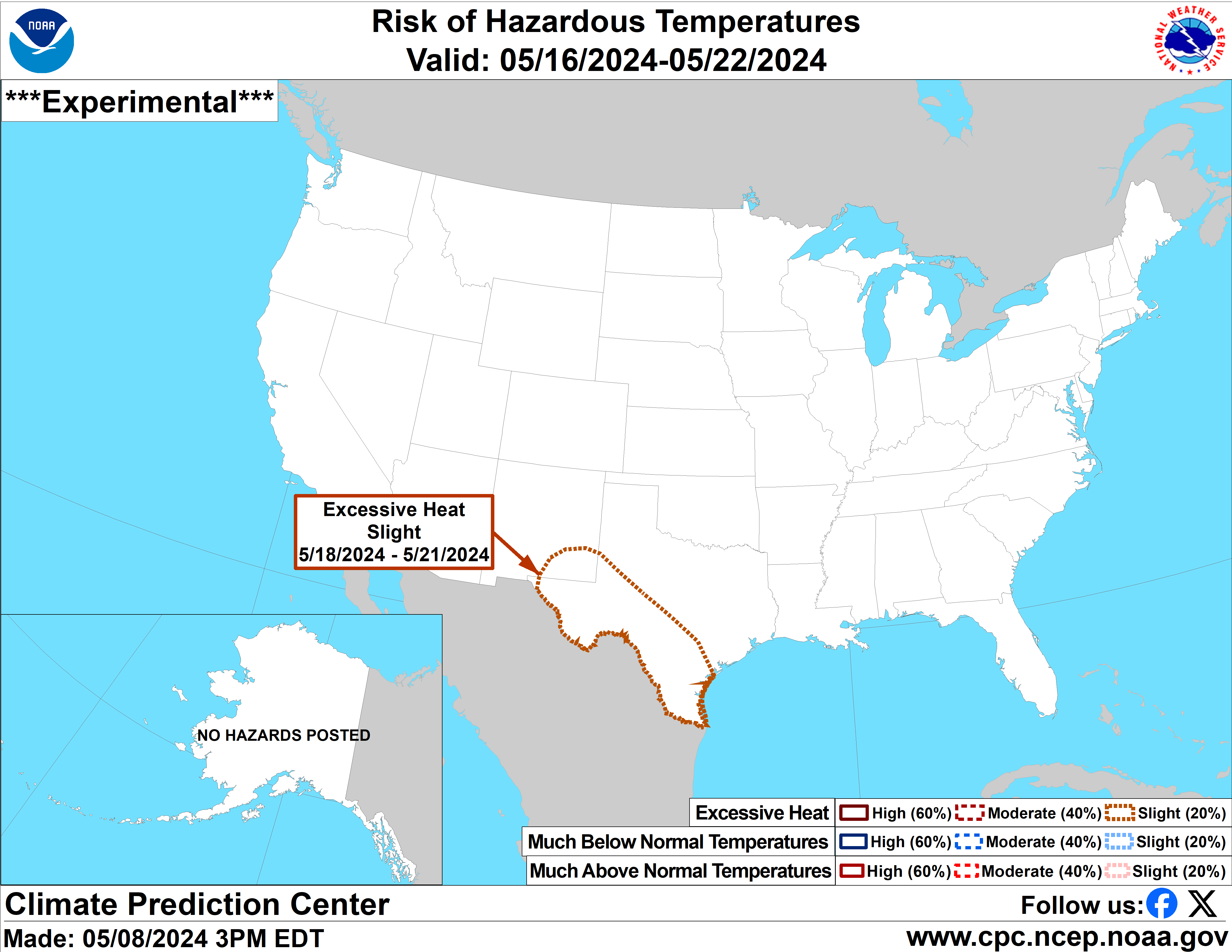
Previous posts:
+++++++++++++++++++++++++++
By metmike - Dec. 30, 2019, 11:13 a.m.
Actual totals...big area with 4-6 feet
+++++++++++++++++++++++
By metmike - Dec. 30, 2019, 11:14 a.m.
More than double the normal snowfall so far this winter for a big part of the Dakotas
+++++++++++++++++++++++++++++++++++++
By metmike - Dec. 30, 2019, 11:17 a.m.
·
This cant be caused by 410 ppm co2, Off the charts warm area, but look to the east, Though smaller, off the charts cold showing up ( pink) has to be something natural occurring, perhaps of sub ocean origin ( thermal bursts from crust) compensating cooling out side of warmth
metmike: The map above with the warmth is the Northeast Pacific.
+++++++++++++++++++++++++++++++++++
By metmike - Dec. 30, 2019, 1:16 p.m.
·
Top 3-Clusters (per http://wsitrader.com) of 500mb geopotential height anomalies averaged over the 11-15d period from the GEFS, ECMWF, and GEM Ensembles. LOCK IT IN: An upcoming high-amplitude ridge over the North Pacific, forcing a downstream -PNA response over the U.S.
++++++++++++++++++++++++++++++++++++++
By metmike - Dec. 31, 2019, 11:31 a.m.
Adding by popular demand a map of estimated snow accumulation throughout the 2010s across the continental US:
+++++++++++++++++++++++++
·
Well if you're hoping for a blizzard during #AMS2020 in #Boston next month, this isn't the pattern that you want to see...
++++++++++++++++++
·
Great agreement on all global ensembles with the development of an anomalous +AO, +NAO and potential for troughing amplifying in the Western US. The result will be the potential for a highly amplified ridge in the Eastern US with well above normal temperatures Jan 10-15.
+++++++++++++++++++++++++++++
By WxFollower - Jan. 1, 2020, 1:15 p.m.
Here is a paper that suggests that extra warming centered in and around Indonesia has been causing an increase in the % of days in MJO phases 4 and 5 (I confirmed with my own counting that this is most evident in winter) which favors E warmth/southeast US ridge dominance in winter:
https://www.nature.com/articles/s41586-019-1764-4
This is not good news if you prefer winters not be mild in the E 1/3 of the US. I’m one of those folks. So, per this paper, GW has resulted in a double whammy of sorts for E US winters as a whole in the warmer direction. Yuck.
++++++++++++++++++++++++++++++++++++++++++++++
By metmike - Jan. 1, 2020, 6:49 p.m.
Thanks much Larry and Happy New Year/Decade.
Looks very interesting but only the abstract can be accessed since its pay walled.
Is the entire study available somewhere?
Somebody posted an animation of the warm pool expansion over the last 70 years in that area with only the 28, 29 and 30 degree isotherms shown with time and they do grow a bit and get slightly warmer but there is no comparision with surrounding water temps and global ocean temperatures to show if this is anomalous and how much greater it might be than those other areas.
Most of the oceans have warmed up over the last 70 years. I would like to see how much MORE this area warmed up COMPARED TO the rest of the oceans because we could pick any region and probably some to possibly similar warming.
CO2 is well mixed in the global atmosphere and the affects are pretty uniform and we have ocean currents mixing and moving the heat around in the oceans, along with natural oceanic cycles that have periodicities on the order of decades in some cases........which have not been observed long enough to make accurate, specific assumptions or predict time frames, I am skeptical of studies that use assumptions that we can't know with high confidence to make conclusions.
I'm not disagreeing with something that I haven't seen yet, just being cautious after seeing the 70 years of the warm pool in this region growing slightly with nothing to compare it too.
Based on the abstract, it sounds pretty convincing.
+++++++++++++++++++++++++++++++++++++++++++++
By WxFollower - Jan. 1, 2020, 7:01 p.m.
Mike,
Happy New Year to you, too. I don't know of any access to the full study.
+++++++++++++++++++++++++++++++++++++++++
Weather Friday
3 responses |
Started by WxFollower - Jan. 3, 2020, 10:46 a.m.
https://www.marketforum.com/forum/topic/45257/
I thought I’d start today’s wx thread with this because it is such an anomalously amplified and stable pattern. The GEFS has maintained its MJO 4/5 amplitude peak prediction at ~3 while the EPS has increased theirs from 2.5 yesterday to nearly 3 today. A peak of 3.0 would make it the 4th highest amp of 4/5 in winter on record (back to 1975). The 2 models are predicting a duration in 4/5 of 10-12 days ending ~1/17. Combine this MJO with a strong -PNA/+AO, a mainly +NAO, and a modest -AAM that is restarting today as well as a mainly +EPO and you have all of the makings for a strong torch to dominate the next 2 weeks in the SE 1/3 of the US. I expect to see several days in the SE, Mid-Atlantic and Ohio River Valley areas with anomalies of +15+ within a period having most days AN. The entire 10-12 days will probably average close to 10+ AN in the SE US and nearby, which would be close to norms for mid March!
Special thanks Larry for your detailed analysis of the pattern on Friday.